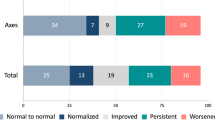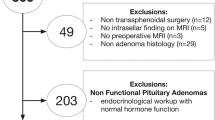Abstract
Background
Transsphenoidal surgery guided by intraoperative MRI (iMRI) is related to higher rates of tumour resection. The influence of iMRI on endocrinological outcome is still unclear. This study evaluates the endocrinological outcome of iMRI-guided transsphenoidal surgery.
Methods
A series of 60 patients operated by iMRI-guidance for inactive adenomas were matched to a previous series of 32 controls. The following factors were used for matching: gender; age; tumour volume; Hardy’s grade; pituitary function; pituitary stalk configuration; stalk effect hyperprolactinemia; arterial hypertension; diabetes mellitus; smoking.
Results
Total resection rates were higher in the iMRI group (85%) than in the control group (69%). Follow-up times were 3.2 ± 1.0 years in the iMRI group and 6.8 ± 4.1 years for controls. No patient in the iMRI group needed additional tumour treatment, as opposed to 13% of the controls. The rate of postoperative hypopituitarism was 29% in the iMRI and 45% in the control group. Predictors for new hypopituitarism in the iMRI group were age >65 years, Hardy’s grade >2 tumours and hypertension. Recovery rates were 59% in the iMRI and 45% for controls. Predictors of better recovery rates were female gender and age <65 years. The following predictors lead to an endocrinological benefit of iMRI-guidance: Hardy’s grade <3 tumours; age <65 years; no hypertension; non-smokers; dysfunction of two or three axes pre-operatively.
Conclusion
The use of iMRI in transsphenoidal surgery for non-functioning pituitary adenoma might lead to higher total resection rates. In our series, resection of remnants detected by iMRI was neither associated with higher incidences of postoperative hypopituitarism nor with lower recovery rates of pituitary axes.

Similar content being viewed by others
References
Abosch A, Tyrrell JB, Lamborn KR, Hannegan LT, Applebury CB, Wilson CB (1998) Transsphenoidal microsurgery for growth hormone-secreting pituitary adenomas: initial outcome and long-term results. J Clin Endocrinol Metab 83:3411–3418
Adams JR, Blevins LS Jr, Allen GS, Verity DK, Devin JK (2006) Disorders of water metabolism following transsphenoidal pituitary surgery: a single institution's experience. Pituitary 9:93–99
Ahn JY, Jung JY, Kim J, Lee KS, Kim SH (2008) How to overcome the limitations to determine the resection margin of pituitary tumours with low-field intra-operative MRI during trans-sphenoidal surgery: usefulness of Gadolinium-soaked cotton pledgets. Acta Neurochir (Wien) 150:763–771, discussion 771
Albayrak B, Samdani AF, Black PM (2004) Intra-operative magnetic resonance imaging in neurosurgery. Acta Neurochir (Wien) 146:543–556, discussion 557
Arafah BM (1986) Reversible hypopituitarism in patients with large nonfunctioning pituitary adenomas. J Clin Endocrinol Metab 62:1173–1179
Arafah BM, Kailani SH, Nekl KE, Gold RS, Selman WR (1994) Immediate recovery of pituitary function after transsphenoidal resection of pituitary macroadenomas. J Clin Endocrinol Metab 79:348–354
Arafah BM, Prunty D, Ybarra J, Hlavin ML, Selman WR (2000) The dominant role of increased intrasellar pressure in the pathogenesis of hypopituitarism, hyperprolactinemia, and headaches in patients with pituitary adenomas. J Clin Endocrinol Metab 85:1789–1793
Barker FG 2nd, Klibanski A, Swearingen B (2003) Transsphenoidal surgery for pituitary tumors in the United States, 1996–2000: mortality, morbidity, and the effects of hospital and surgeon volume. J Clin Endocrinol Metab 88:4709–4719
Baskin DS, Boggan JE, Wilson CB (1982) Transsphenoidal microsurgical removal of growth hormone-secreting pituitary adenomas. A review of 137 cases. J Neurosurg 56:634–641
Baumann F, Schmid C, Bernays RL (2010) Intraoperative magnetic resonance imaging-guided transsphenoidal surgery for giant pituitary adenomas. Neurosurg Rev 33:83–90
Berkmann S, Fandino J, Zosso S, Killer HE, Remonda L, Landolt H (2011) Intraoperative magnetic resonance imaging and early prognosis for vision after transsphenoidal surgery for sellar lesions. J Neurosurg 115:518–527
Black PM, Zervas NT, Candia GL (1987) Incidence and management of complications of transsphenoidal operation for pituitary adenomas. Neurosurgery 20:920–924
Bohinski RJ, Warnick RE, Gaskill-Shipley MF, Zuccarello M, van Loveren HR, Kormos DW, Tew JM Jr (2001) Intraoperative magnetic resonance imaging to determine the extent of resection of pituitary macroadenomas during transsphenoidal microsurgery. Neurosurgery 49:1133–1143, discussion 1143–1134
Cappabianca P, Cavallo LM, Colao A, de Divitiis E (2002) Surgical complications associated with the endoscopic endonasal transsphenoidal approach for pituitary adenomas. J Neurosurg 97:293–298
Ciric I, Ragin A, Baumgartner C, Pierce D (1997) Complications of transsphenoidal surgery: results of a national survey, review of the literature, and personal experience. Neurosurgery 40:225–236, discussion 236–227
Colao A, Cerbone G, Cappabianca P, Ferone D, Alfieri A, Di Salle F, Faggiano A, Merola B, de Divitiis E, Lombardi G (1998) Effect of surgery and radiotherapy on visual and endocrine function in nonfunctioning pituitary adenomas. J Endocrinol Invest 21:284–290
Comtois R, Beauregard H, Somma M, Serri O, Aris-Jilwan N, Hardy J (1991) The clinical and endocrine outcome to trans-sphenoidal microsurgery of nonsecreting pituitary adenomas. Cancer 68:860–866
Darakchiev BJ, Tew JM Jr, Bohinski RJ, Warnick RE (2005) Adaptation of a standard low-field (0.3-T) system to the operating room: focus on pituitary adenomas. Neurosurg Clin N Am 16:155–164
De Witte O, Makiese O, Wikler D, Levivier M, Vandensteene A, Pandin P, Baleriaux D, Brotchi J (2005) Transsphenoidal approach with low field MRI for pituitary adenoma. Neurochirurgie 51:577–583
Fahlbusch R, Ganslandt O, Buchfelder M, Schott W, Nimsky C (2001) Intraoperative magnetic resonance imaging during transsphenoidal surgery. J Neurosurg 95:381–390
Fahlbusch R, Keller B, Ganslandt O, Kreutzer J, Nimsky C (2005) Transsphenoidal surgery in acromegaly investigated by intraoperative high-field magnetic resonance imaging. Eur J Endocrinol 153:239–248
Faria MA Jr, Tindall GT (1982) Transsphenoidal microsurgery for prolactin-secreting pituitary adenomas. J Neurosurg 56:33–43
Fatemi N, Dusick JR, Mattozo C, McArthur DL, Cohan P, Boscardin J, Wang C, Swerdloff RS, Kelly DF (2008) Pituitary hormonal loss and recovery after transsphenoidal adenoma removal. Neurosurgery 63:709–718, discussion 718–709
Gerlach R, du Mesnil de Rochemont R, Gasser T, Marquardt G, Reusch J, Imoehl L, Seifert V (2008) Feasibility of Polestar N20, an ultra-low-field intraoperative magnetic resonance imaging system in resection control of pituitary macroadenomas: lessons learned from the first 40 cases. Neurosurgery 63:272–284, discussion 284–275
Goldstein LB, Adams R, Alberts MJ, Appel LJ, Brass LM, Bushnell CD, Culebras A, Degraba TJ, Gorelick PB, Guyton JR, Hart RG, Howard G, Kelly-Hayes M, Nixon JV, Sacco RL (2006) Primary prevention of ischemic stroke: a guideline from the American Heart Association/American Stroke Association Stroke Council: cosponsored by the Atherosclerotic Peripheral Vascular Disease Interdisciplinary Working Group; Cardiovascular Nursing Council; Clinical Cardiology Council; Nutrition, Physical Activity, and Metabolism Council; and the Quality of Care and Outcomes Research Interdisciplinary Working Group: the American Academy of Neurology affirms the value of this guideline. Stroke 37:1583–1633
Gorczyca W, Hardy J (1987) Arterial supply of the human anterior pituitary gland. Neurosurgery 20:369–378
Hardy J, Wigser SM (1965) Transsphenoidal surgery of pituitary fossa tumors with televised radiofluoroscopic control. J Neurosurg 23:612–619
Hirschl RA, Wilson J, Miller B, Bergese S, Chiocca EA (2009) The predictive value of low-field strength magnetic resonance imaging for intraoperative residual tumor detection. Clinical article. J Neurosurg 111:252–257
Jones J, Ruge J (2007) Intraoperative magnetic resonance imaging in pituitary macroadenoma surgery: an assessment of visual outcome. Neurosurg Focus 23:E12
Lewin JS, Nour SG, Meyers ML, Metzger AK, Maciunas RJ, Wendt M, Duerk JL, Oppelt A, Selman WR (2007) Intraoperative MRI with a rotating, tiltable surgical table: a time use study and clinical results in 122 patients. AJR Am J Roentgenol 189:1096–1103
Lundin P, Pedersen F (1992) Volume of pituitary macroadenomas: assessment by MRI. J Comput Assist Tomogr 16:519–528
Marazuela M, Astigarraga B, Vicente A, Estrada J, Cuerda C, Garcia-Uria J, Lucas T (1994) Recovery of visual and endocrine function following transsphenoidal surgery of large nonfunctioning pituitary adenomas. J Endocrinol Invest 17:703–707
Martin CH, Schwartz R, Jolesz F, Black PM (1999) Transsphenoidal resection of pituitary adenomas in an intraoperative MRI unit. Pituitary 2:155–162
McPherson CM, Bohinski RJ, Dagnew E, Warnick RE, Tew JM (2003) Tumor resection in a shared-resource magnetic resonance operating room: experience at the University of Cincinnati. Acta Neurochir Suppl 85:39–44
Nelson AT Jr, Tucker HS Jr, Becker DP (1984) Residual anterior pituitary function following transsphenoidal resection of pituitary macroadenomas. J Neurosurg 61:577–580
Nemergut EC, Zuo Z, Jane JA Jr, Laws ER Jr (2005) Predictors of diabetes insipidus after transsphenoidal surgery: a review of 881 patients. J Neurosurg 103:448–454
Nimsky C, Ganslandt O, Fahlbusch R (2004) Functional neuronavigation and intraoperative MRI. Adv Tech Stand Neurosurg 29:229–263
Nimsky C, Ganslandt O, Fahlbusch R (2005) Comparing 0.2 tesla with 1.5 tesla intraoperative magnetic resonance imaging analysis of setup, workflow, and efficiency. Acad Radiol 12:1065–1079
Nimsky C, Ganslandt O, Hofmann B, Fahlbusch R (2003) Limited benefit of intraoperative low-field magnetic resonance imaging in craniopharyngioma surgery. Neurosurgery 53:72–80, discussion 80–71
Nimsky C, von Keller B, Ganslandt O, Fahlbusch R (2006) Intraoperative high-field magnetic resonance imaging in transsphenoidal surgery of hormonally inactive pituitary macroadenomas. Neurosurgery 59:105–114, discussion 105–114
Nomikos P, Ladar C, Fahlbusch R, Buchfelder M (2004) Impact of primary surgery on pituitary function in patients with non-functioning pituitary adenomas—a study on 721 patients. Acta Neurochir (Wien) 146:27–35
Olson BR, Gumowski J, Rubino D, Oldfield EH (1997) Pathophysiology of hyponatremia after transsphenoidal pituitary surgery. J Neurosurg 87:499–507
Pamir MN, Peker S, Ozek MM, Dincer A (2006) Intraoperative MR imaging: preliminary results with 3 tesla MR system. Acta Neurochir Suppl 98:97–100
Pandin P, Dewitte O (2007) Open low-field intraoperative MRI for transsphenoidal pituitary surgery. Anesth Analg 105:886
Pergolizzi RS Jr, Nabavi A, Schwartz RB, Hsu L, Wong TZ, Martin C, Black PM, Jolesz FA (2001) Intra-operative MR guidance during trans-sphenoidal pituitary resection: preliminary results. J Magn Reson Imaging 13:136–141
Pinto A, Tuttolomondo A, Di Raimondo D, Fernandez P, Licata G (2004) Cerebrovascular risk factors and clinical classification of strokes. Semin Vasc Med 4:287–303
Randall RV, Scheithauer BW, Laws ER Jr, Abbound CF, Ebersold MJ, Kao PC (1985) Pituitary adenomas associated with hyperprolactinemia: a clinical and immunohistochemical study of 97 patients operated on transsphenoidally. Mayo Clin Proc 60:753–762
Randeva HS, Schoebel J, Byrne J, Esiri M, Adams CB, Wass JA (1999) Classical pituitary apoplexy: clinical features, management and outcome. Clin Endocrinol (Oxf) 51:181–188
Robinson AG, Verbalis JG (1994) Diabetes insipidus. Curr Ther Endocrinol Metab 5:1–6
Schulder M, Jacobs A, Carmel PW (2001) Intraoperative MRI and adjuvant radiosurgery. Stereotact Funct Neurosurg 76:151–158
Schwartz TH, Stieg PE, Anand VK (2006) Endoscopic transsphenoidal pituitary surgery with intraoperative magnetic resonance imaging. Neurosurgery 58:ONS44–ONS51, discussion ONS44-51
Semple PL, Webb MK, de Villiers JC, Laws ER Jr (2005) Pituitary apoplexy. Neurosurgery 56:65–72, discussion 72–63
Shou XF, Li SQ, Wang YF, Zhao Y, Jia PF, Zhou LF (2005) Treatment of pituitary adenomas with a transsphenoidal approach. Neurosurgery 56:249–256, discussion 249–256
Singer PA, Sevilla LJ (2003) Postoperative endocrine management of pituitary tumors. Neurosurg Clin N Am 14:123–138
Steinmeier R, Fahlbusch R, Ganslandt O, Nimsky C, Buchfelder M, Kaus M, Heigl T, Lenz G, Kuth R, Huk W (1998) Intraoperative magnetic resonance imaging with the magnetom open scanner: concepts, neurosurgical indications, and procedures: a preliminary report. Neurosurgery 43:739–747, discussion 747–738
Webb SM, Rigla M, Wagner A, Oliver B, Bartumeus F (1999) Recovery of hypopituitarism after neurosurgical treatment of pituitary adenomas. J Clin Endocrinol Metab 84:3696–3700
Wu JS, Shou XF, Yao CJ, Wang YF, Zhuang DX, Mao Y, Li SQ, Zhou LF (2009) Transsphenoidal pituitary macroadenomas resection guided by PoleStar N20 low-field intraoperative magnetic resonance imaging: comparison with early postoperative high-field magnetic resonance imaging. Neurosurgery 65:63–70, discussion 70–61
Zayour DH, Selman WR, Arafah BM (2004) Extreme elevation of intrasellar pressure in patients with pituitary tumor apoplexy: relation to pituitary function. J Clin Endocrinol Metab 89:5649–5654
Conflicts of interest
None.
Author information
Authors and Affiliations
Corresponding author
Rights and permissions
About this article
Cite this article
Berkmann, S., Fandino, J., Müller, B. et al. Intraoperative MRI and endocrinological outcome of transsphenoidal surgery for non-functioning pituitary adenoma. Acta Neurochir 154, 639–647 (2012). https://doi.org/10.1007/s00701-012-1285-5
Received:
Accepted:
Published:
Issue Date:
DOI: https://doi.org/10.1007/s00701-012-1285-5




